How to Compete for Patients in the Digital Age
Reputation Staff Writer

A Guide for Chief Marketing Officers
Executive Summary
Creating competitive advantage starts with a sound digital strategy.
In a 2017 survey of healthcare consumers across the U.S. from a representative range of demographic groups, we found that 88% of consumers begin their search for healthcare providers online. Consumers rely on search engines and review sites to steer their decisions about where to go for care.
What consumers read about you online heavily influences their decision-making. Your reputation is defined at every touchpoint a potential patient has with your doctors and organization on the web — from the doctor or location listing, to patient rating and reviews, to finding the right doctor and reading profiles on your website. Done well, online reputation management (ORM) enables your providers to generate a high volume of representative reviews from the “silent majority,” while providing valuable insights to improve patient experience, make operational improvements and drive new patient appointments.
What’s in this White Paper?
In this white paper, we examine this new online reality and share key recommendations to help you build a strong online reputation, attract and retain patients, and maintain a competitive advantage.
- Key trends impacting healthcare marketing today
- How to be a trusted guide for your customers on their digital journey
- How to close the loop by taking action on patient feedback
- How to get started with online reputation management (ORM)
Key Trends in Healthcare Marketing
Three key trends are having a significant impact on the way healthcare organizations attract and retain customers:
- The power to define your brand resides with patients
- Healthcare branding is hyper-local
- Consumers don’t start on your website
Trend 1: The Power to Define Your Brand Resides with Patients
You can’t buy brand equity anymore.
There was a time when marketers with adequate cash controlled their brands. Online reviews have led to total market transparency for healthcare organizations. This tilts the balance of branding power away from healthcare marketing teams and into the hands of patients. Marketers can choose to either co-create their brands by engaging with their patients online, or let customers do it on their own.
Trend 2: Healthcare Branding is Hyper-Local
Does your online reputation reflect the brand you’ve worked so hard to build?
Brand perception begins online, with the local online reputation of doctors, clinics and hospitals. The problem? Each of your physicians and locations has a point of presence on many different websites and search engines — and each point can collect and display patient reviews. This means a large healthcare organization must monitor and manage reviews for its doctors and locations across thousands — in some cases hundreds of thousands — of digital touch points.
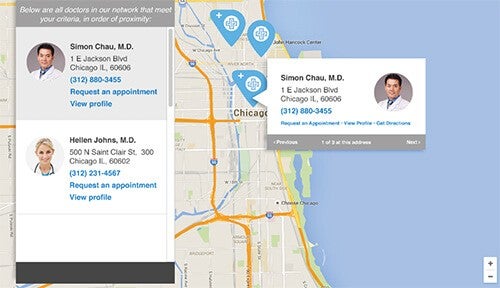
In this fast-moving, dispersed and hyperlocal environment it’s a herculean task to ensure the brand message is consistent and representative across all digital touchpoints.
Trend 3: Consumers Don’t Start on Your Website
Today, 73% of healthcare marketers see their brand’s website as their virtual front door. But this is not where consumers start when they are looking for care.
In fact, according to Reputation.com’s consumer survey, less than 10% of consumers start their search on a brand’s website. Instead, most turn to search engines or health insurance websites. If you rely solely on paid and organic traffic to your website, you’re severely limiting your ability to attract patients who are looking for care.

Prioritize your physicians’ and locations’ business listings, especially on Google My Business (GMB) — and the reviews and ratings those listings showcase. Listings on a search engine results page (SERP) are often the first thing a potential patient sees, and are the primary jumping-off point to your website, especially if you rank high in search. As such, they stand between a patient looking for care and visiting your site.
How Healthcare Consumers Search for Different Types of Care
Patients are on a Journey — Be Their Guide
To win patients, healthcare organizations must develop a comprehensive strategy to guide consumers — from discovery to selection to scheduling.
Let’s look at the patient’s digital journey to understand how they find and select a doctor:

Search: Patients have a healthcare need and start their search for care at a search engine. How you show up in search results determines if they even go to the next step with you.

Evaluation: Next, patients evaluate you based on factors such as the completeness of your Google MyBusiness listings and your ratings and reviews. If they can’t find what they need or don’t like what they see, they’ll choose another provider.

Validation: Patients click on your doctor or location’s link from a SERP and visit your site. Once there they want to see their options with a simple and easy-to-use find-a-doctor tool.

Scheduling: To make a final decision and an appointment, patients want to evaluate options — read rich profiles of possible doctors to make their final decision, including patient reviews, hours, location, video bios and other background data. They want to close the loop by scheduling an appointment right from the profile page.
There are four essential steps to meeting patients along their digital journey:
- Ensure you have accurate business listings on all major search engines.
- Make a great first impression with high ratings and rankings, and a large volume of recent, high-quality reviews.
- Enable potential patients to easily find a doctor or location that meets their needs with an intuitive, easy-to-use find-a-doctor tool.
- Merchandise your doctors effectively with rich physician profiles and directly-integrated scheduling.

Ensure you have accurate business listings on all major search engines.
According to Google, consumers are 38% more likely to visit — and 29% more likely to consider purchasing from — businesses with complete business listings. And Google takes your listing accuracy and consistency across multiple sites into account when determining where your locations rank in relation to similar providers in search. This means that a patient’s ability to find and choose you literally depends on the quality and accuracy of your listing’s data.
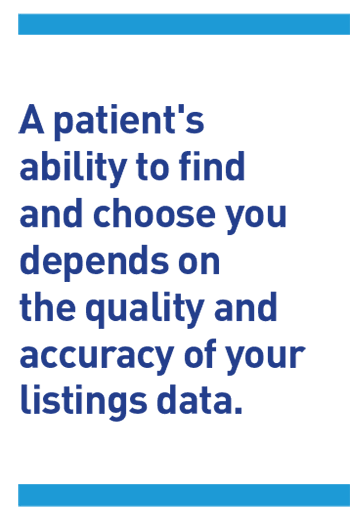
But with hundreds or thousands of physicians and locations to manage, many large organizations struggle with maintaining clean, accurate data and updating every listing online. In fact, only 37% of businesses have claimed all their location listings — and healthcare is no exception.
According to Pew Research, 77% of healthcare seekers start their search on a search engine. If your listings are incorrect, out-dated — or worse, completely missing — you remain unseen, and you lose business. Incorrect information may seem benign, but it initiates a poor customer experience that could frustrate patients when they are looking for a provider, and encourage them to go to a competitor.

Make a great first impression with good ratings and rankings, and a high volume of recent, high-quality reviews.
Consumers actively seek out patient reviews when searching for providers. And they want to read several. But providers aren’t giving consumers the information they need.
Our research revealed that providers don’t have enough reviews. We found 79% of healthcare consumers want to read six or more online reviews as they evaluate doctors, but 77% of providers have zero Google reviews, and those who do have an average of just one review.
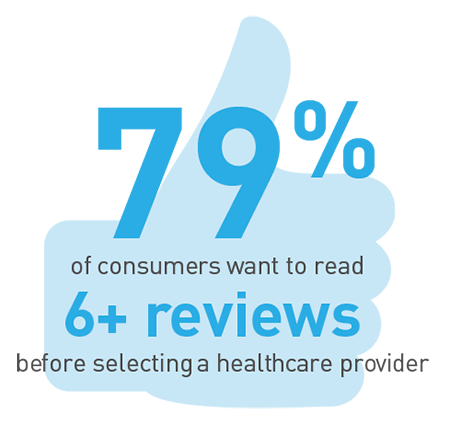
Also, most providers’ reviews are too old — 52% of consumers want to see a review written within the past six months. But among providers who have a review on Google, the average most recent review is nine months old.
Meeting these expectations requires a reliable, repeatable process for proactively requesting patient reviews following visits. A comprehensive ORM platform simplifies the review requesting and management process in the following ways:
- Enables providers to easily request reviews via email, text or in-office tablets
- Sends automated emails when reviews come in, so teams can react quickly
- Routes reviews with complaints to the right people for fast resolution through integrated ticketing
- Enables providers to respond to reviews directly from within the ORM platform
- Provides templates to support HIPAA compliance
- Unifies data from online reviews, patient surveys and doctor listings
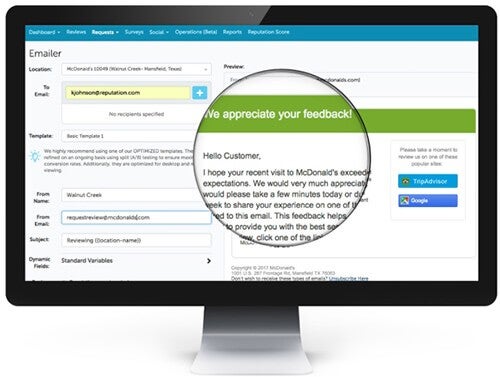
By acting as a trusted source of relevant information in the form of patient reviews, you’re demonstrating your commitment to your patients and the community and helping to improve the overall patient experience.

Help patients find a doctor or location with an intuitive, easy-to-use doctor finder.
Once healthcare consumers find you online and click on your site, they expect an easy transition to evaluating and selecting a doctor or location. Consumers are not medical professionals; they need a tool that allows them to use lay terms to search for care providers. For example, they can type “knee pain” to find orthopedic doctors near them.
The best find-a-doctor tools enable patients to search for and compare physicians based on an expansive number of profile fields, and to filter results by various parameters, including location and accepted insurance. Even within your site, patients want to see reviews and star ratings from a variety of sources — such as CAHPS survey data and third-party review sites.
At every step of the process you need to help patients compare options and be confident in their choice. The more relevant, rich and current the information you provide, the more likely they are to choose your providers and facilities.

Merchandise your doctors effectively with rich profiles and integrated scheduling.
Today’s healthcare consumers expect an immediate transition to a transaction — in this case, the ability to schedule an appointment from within the doctor’s profile page. Integrating the directory management back-end data with the consumer-facing find-a-doctor tool optimizes the patient’s online experience from start to finish, and minimizes the likelihood they will go elsewhere to select a physician.
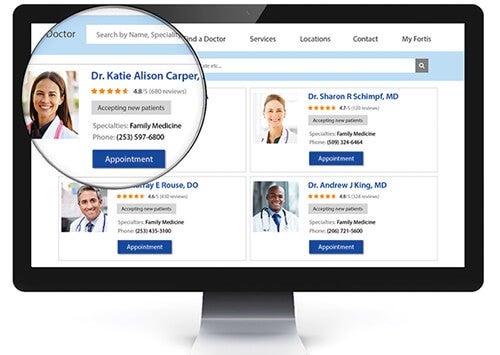
The directory management solution creates a single source of truth for all location and doctor data, on your website as well as across search engines and third-party review sites. So, if a customer starts by searching for a specific physician on Google or a third-party site you can be confident the physician and location data they find is accurate.
The smoother you make the discovery and engagement process, the more likely they are to continue through to your site and to booking an appointment.
Close the Loop: Take Action on Patient Feedback
Analyze data from reviews, social media and surveys to empower operations.
The link between marketing and operations is becoming more critical, and healthcare organizations have an exciting opportunity to use customer input from online reviews to initiate positive change in the way care is delivered. Insights from online reviews and feedback can help organizations define KPIs and improve important parts of patient care, from access to parking, to how the front-desk staffgreets patients, to billing procedures after a visit.
The data and downstream reports provided by ORM platforms such as Reputation.com help healthcare providers track, measure and report on these KPIs with an incredible level of granularity — from entire high-level system views, to regional, clinic and individual office or physician performance. Leading health systems have even tied their compensation and bonus systems directly to online reputation KPIs measured through the ORM system.
Importantly, the analysis of and response to customer feedback must happen in near-real time. Unaddressed negative feedback can still have a deep and longlasting impact on the healthcare organization’s brand and business performance.
A unified combination of real-time insights and regular status reports — ideally generated and sent automatically to executive and operations teams — enables data-driven decisions, informs staff training and motivates teams to improve the way they deliver service to patients.
Get Started with ORM in Your Organization
Leading healthcare marketers are finding that integrating online reputation management (ORM) into their overall digital strategy is essential to continued business growth and success. Online reputation is defining prospective patients’ first impressions when they have a healthcare need.
But it doesn’t stop there. A comprehensive strategy for guiding potential patients from discovery to selection to scheduling will enable you to maintain an advantage in the increasingly competitive — and digital — healthcare industry.
Follow these best practices to get started:
- Establish an accurate online presence — including business listings on all major directory and review sites, particularly Google.
- Monitor and respond to reviews on major third-party review sites.
- Ask all of your patients to write reviews on major third-party review sites to create a representative and accurate picture of the care you provide.
- Optimize patient experience throughout the entire journey with a streamlined find-a-doctor and directory management solution.
- Use advanced analytics and reporting to mine reviews for insights that can be shared with operations to improve patient experience.
